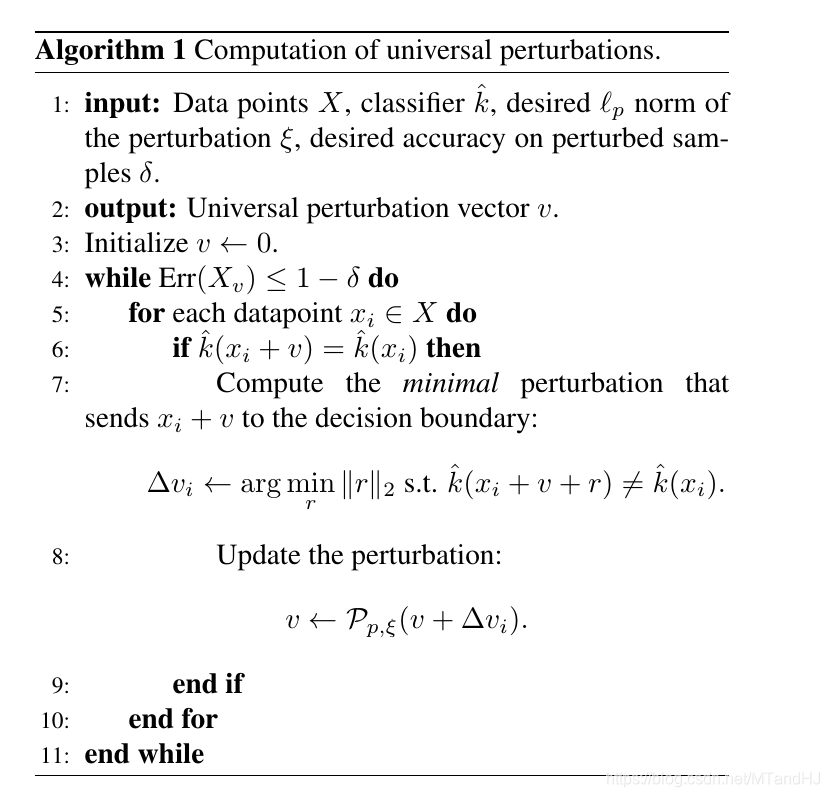@article{moosavidezfooli2017universal,
title={Universal Adversarial Perturbations},
author={Moosavidezfooli, Seyedmohsen and Fawzi, Alhussein and Fawzi, Omar and Frossard, Pascal},
pages={86--94},
year={2017}}
概
深度学习的脆弱以及周知了, 但是到底脆弱到何种程度, 本文作者发现, 可以找到一种对抗摄动, 令其作用在不同的数据上, 结果大部分都会被攻破(即被网络误判). 甚至, 这种对抗摄动可以跨越网络结构的障碍, 即在这个网络结构上的一般性的对抗摄动, 也能有效地攻击别的网络.
主要内容
一般地对抗样本, 是针对特定的网络(hat{k}), 特定的样本(x_i in mathbb{R}^d), 期望找到摄动(v_i in mathbb{R}^d), 使得
而本文的通用摄动(universal perturbations)是希望找到一个(v, |v|_p le xi), 且
其中(mu)为数据的分布.
算法
构造这样的(v)的算法如下:

其中
为向(p)范数球的投影.
实验部分
实验1
实验1, 在训练数据集(ILSVRC 2012)(X)上(摄动是在此数据上计算得到的), 以及在验证数据集上, 攻击不同的网络.

实验2
实验2测试这种通用摄动的网络结构的转移性, 即在一个网络上寻找摄动, 在其它模型上计算此摄动的攻击成功率. 可见, 这种通用摄动的可迁移性是很强的.

实验3
实验3, 研究了样本个数对攻击成功率的一个影响, 可以发现, 即便我们用来生成摄动的样本个数只有500(少于类别个数1000)都能有不错的成功率.

代码
代码因为还有用到了别的模块, 这放在这里看看, 论文有自己的代码.
import torch
import logging
from configs.adversarial.universal_attack_cfg import cfg
sub_logger = logging.getLogger("__main__.__submodule__")
class AttackUni:
def __init__(self, net, device,
attack=cfg.attack, epsilon=cfg.epsilon, attack_cfg=cfg.attack_cfg,
max_iterations=cfg.max_iterations, fooling_rate=cfg.fooling_rate,
boxmin=0., boxmax=1.):
""" the attack to construct universal perturbation
:param net: the model
:param device: may use gpu to train
:param attack: default: PGDAttack
:param epsilon: the epsilon to constraint the perturbation
:param attack_cfg: the attack's config
:param max_iterations: max_iterations for stopping early
:param fooling_rate: the fooling rate we want
:param boxmin: default: 0
:param boxmax: default: 1
"""
attack_cfg['net'] = net
attack_cfg['device'] = device
self.net = net
self.device = device
self.epsilon = epsilon
self.attack = attack(**attack_cfg)
self.max_iterations = max_iterations
self.fooling_rate = fooling_rate
self.boxmin = boxmin
self.boxmax = boxmax
def initialize_perturbation(self):
self.perturbation = torch.tensor(0., device=self.device)
def update_perturbation(self, perturbation):
self.perturbation += perturbation
self.perturbation = self.clip(self.perturbation).to(self.device)
def clip(self, x):
return torch.clamp(x, -self.epsilon, self.epsilon)
def compare(self, x, label):
x_adv = x + self.perturbation
out = self.net(x_adv)
pre = out.argmax(dim=1)
return (pre == label).sum()
def attack_one(self, img):
result = self.attack.attack_batch(img+self.perturbation)
perturbation = result['perturbations'][0]
self.update_perturbation(perturbation)
def attack_batch(self, dataloader):
total = len(dataloader)
self.initialize_perturbation()
for epoch in range(self.max_iterations):
count = 0
for img, label in dataloader:
img = img.to(self.device)
label = img.to(self.device)
if self.compare(img, label):
self.attack_one(img)
else:
count += 1
if count / total > self.fooling_rate:
break
sub_logger.info("[epoch: {0:<3d}] 'fooling_rate': {1:<.6f}".format(
epoch, count / total
))
return self.perturbation